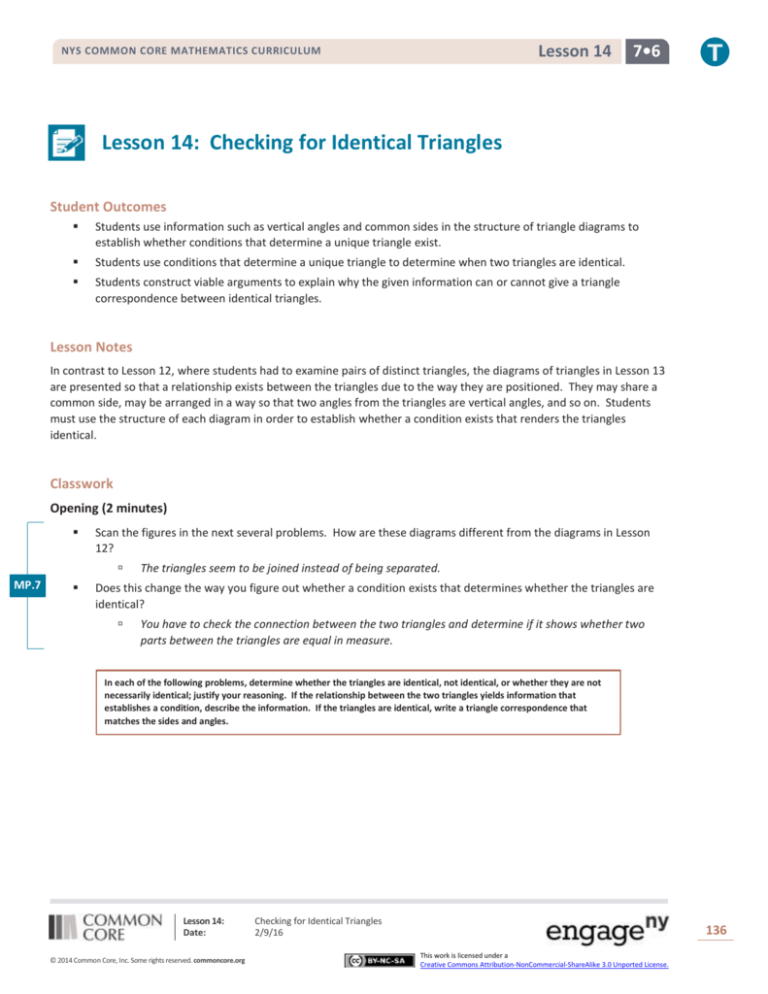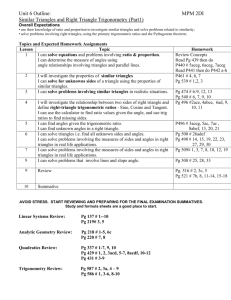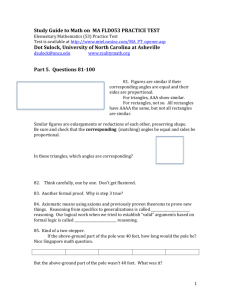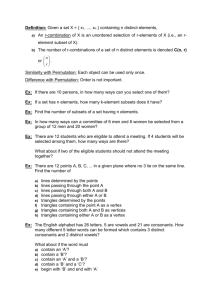
Lesson 14
NYS COMMON CORE MATHEMATICS CURRICULUM
7•6
Lesson 14: Checking for Identical Triangles
Student Outcomes
Students use information such as vertical angles and common sides in the structure of triangle diagrams to
establish whether conditions that determine a unique triangle exist.
Students use conditions that determine a unique triangle to determine when two triangles are identical.
Students construct viable arguments to explain why the given information can or cannot give a triangle
correspondence between identical triangles.
Lesson Notes
In contrast to Lesson 12, where students had to examine pairs of distinct triangles, the diagrams of triangles in Lesson 13
are presented so that a relationship exists between the triangles due to the way they are positioned. They may share a
common side, may be arranged in a way so that two angles from the triangles are vertical angles, and so on. Students
must use the structure of each diagram in order to establish whether a condition exists that renders the triangles
identical.
Classwork
Opening (2 minutes)
Scan the figures in the next several problems. How are these diagrams different from the diagrams in Lesson
12?
MP.7
The triangles seem to be joined instead of being separated.
Does this change the way you figure out whether a condition exists that determines whether the triangles are
identical?
You have to check the connection between the two triangles and determine if it shows whether two
parts between the triangles are equal in measure.
In each of the following problems, determine whether the triangles are identical, not identical, or whether they are not
necessarily identical; justify your reasoning. If the relationship between the two triangles yields information that
establishes a condition, describe the information. If the triangles are identical, write a triangle correspondence that
matches the sides and angles.
Lesson 14:
Date:
© 2014 Common Core, Inc. Some rights reserved. commoncore.org
Checking for Identical Triangles
2/9/16
136
This work is licensed under a
Creative Commons Attribution-NonCommercial-ShareAlike 3.0 Unported License.
Y
X
B
n T hir t een,A Checking for I dent ical
Tr iangles
Out comes: St udent s use condit ions t hat det ermine a unique t riangle t o const ruct viable
COMMON
CORE
nt s t hat two NYS
t riangles
are ident
ical.MATHEMATICS
T hey use givenCURRICULUM
informat ion, common sides, and vert ical
o arrive at t heir conclusions. T hey crit ique t he reasoning of ot hers.
7•6
Lesson 14
angle correspondence 4 B AC $ 4 Z X Y mat ches one pair of equal angles and two
ngequal
I dentsides.
ical TrSince
iangles
t he given angle is t he included angle between t he two sides, two
of t he following problems two t riangles are given. If possible give t he t riangle condit ions
nd
an included
angleare
doident
det ermine
a unique t riangle. T he two t riangles are ident ical.
plain why tExample
he t riangles
ical and writ e a t riangle correspondence t hat mat ches t he
1 (5 minutes)
d angles. If t here is not sufficient informat ion t o det ermine t hat t he t riangles are ident ical,
Z , \ B = \ Y , AB = Y Z .
e. T he figures are not always drawn t o scale.
Example 1
Z, \ B = \ Y, BC = X Y.
What is the relationship between the two triangles below?
Z, \ B = \ Y, BC = X Z.
W
X
r t een, Checking for I dent ical Tr iangles
comes: St udent s use condit ions t hat det ermine a unique t riangle t o const ruct viable
Z
Y
at two t riangles are
ident ical. T hey use given
informat ion, common sides, and vert ical
ve at t heir conclusions. T hey crit ique t he reasoning of ot hers.
What is the relationship between the two triangles below?
ent ical Tr iangles
olut ion: Ident ical t riangles.
4 X triangles
Y W $ 4 Z W Ta by
t he t hree
ion for ident ical
The
common
side.sides condit
e following problems two
t riangles share
are given.
If possible
give t he t riangle condit ions
iangles.
Imagine
that ical
△ 𝑊𝑋𝑌
△e
𝑊𝑍𝑌
were pulled
apart and separated.
Sketch
triangles separately. Based on
why
t he t riangles
are ident
andand
writ
a t riangle
correspondence
t hat mat
chesthe
t he
MP.7
howsufficient
they wereinformat
joined, what
of tick
markt should
betadded
to each
triangle?
gles. If t here is not
ion kind
t o det
ermine
hat t he
riangles
are ident
ical,
drawn
𝑊𝑌 is a tcommon
e figures are not always
o scale.side. Since it belongs to each triangle, we should put a triple tick mark on 𝑊𝑌 to
indicate that it is a part of equal measure in both triangles.
W
Z
W
X
Y
Z
W
X
Y
Y
Are the triangles identical? How do you know?
The triangles are identical by the three side condition. The correspondence that matches the three
n: Ident ical t riangles. 4equal
X YW
Z WisT△ by
t he
sides condit ion for ident ical
pairs$of 4sides
𝑊𝑋𝑌
↔ t△hree
𝑌𝑍𝑊.
es.
Exercises 1–2 (8 minutes)
Scaffolding:
Exercises 1–2
1.
Are the triangles identical? Justify your reasoning.
As shown above, consider
modeling the process of
sketching the triangles as
“unattached” to one another.
The triangles are not necessarily identical. The correspondence △ 𝑸𝑹𝑻 ↔ △ 𝑺𝑹𝑻 matches a pair of equal angles and
a pair of equal sides. The correspondence also matches a common side, 𝑹𝑻, to both triangles. Two sides and a nonincluded acute angle do not necessarily determine a unique triangle.
Lesson 14:
Date:
© 2014 Common Core, Inc. Some rights reserved. commoncore.org
Checking for Identical Triangles
2/9/16
137
This work is licensed under a
Creative Commons Attribution-NonCommercial-ShareAlike 3.0 Unported License.
Lesson 14
NYS COMMON CORE MATHEMATICS CURRICULUM
2.
7•6
Are the triangles identical? Justify your reasoning.
These triangles are identical by the two angles and side opposite a given angle condition. The correspondence △
𝑬𝑭𝑯 ↔△ 𝑮𝑭𝑯 matches two pairs of equal angles and a pair of equal sides. ∠𝑯𝑭𝑬 must be a right angle, since
∠𝑯𝑭𝑮 is a right angle, and they are both on a line. Also, 𝑯𝑭 is a common side to both triangles. Since both
triangles have parts under the condition of the same measurement, the triangles must be identical.
Example 2 (5 minutes)
What is the relationship between the two triangles below?
The triangle is positioned so that there is a pair of vertical angles, ∠𝐴𝑂𝐶 = ∠𝐵𝑂𝐷, in the diagram.
Example 2
Are the triangles identical? Justify your reasoning.
D
A
The triangles are identical by the two sides and the included angle
condition. The correspondence △ 𝑨𝑶𝑪 ↔△ 𝑩𝑶𝑫 matches two equal
pairs of sides and a pair of equal angles, ∠𝑨𝑶𝑪 = ∠𝑩𝑶𝑫, which we
know to be equal in measurement because they are vertical angles.
B
O
C
Exercises 3–4 (8 minutes)
T he vert ical angles \ AOC and \ D OB are equal. 4 OAC $ 4 OB D by t he two
included angle condit
ion3–4for ident ical t riangles.
Exercises
3.
Are the triangles identical? Justify your reasoning.
T
Q
R
S
These triangles are identical by the two angles and side opposite a
given angle condition. The correspondence △ 𝑨𝑶𝑩 ↔△ 𝑪𝑶𝑫
matches the two pairs of equal angles and one pair of equal sides.
There is a marked pair of equal sides and one pair of marked, equal
angles. The second pair of equal angles, ∠𝑨𝑶𝑩 = ∠𝑪𝑶𝑫, are vertical
angles.
T he t riangles 4 QRT and 4 SRT need not be ident ical. T he t riangle correspondence
$ 4 SRT mat ches an angle and two sides T wo sides and a non-included acut e
not necessarily det ermine a unique t riangle. In part icular, \ SRT and \ QRT are
ent ary, but t hey need not be equal.
Lesson 14:
Date:
© 2014 Common Core, Inc. Some rights reserved. commoncore.org
H
Checking for Identical Triangles
2/9/16
138
This work is licensed under a
Creative Commons Attribution-NonCommercial-ShareAlike 3.0 Unported License.
Lesson 14
NYS COMMON CORE MATHEMATICS CURRICULUM
4.
7•6
Are the triangles identical? Justify your reasoning.
The triangles are not necessarily identical. The correspondence △
𝑨𝑬𝑩 ↔△ 𝑪𝑬𝑫 matches three pairs of equal angles, including the
unmarked angles, ∠𝑨𝑬𝑩 and ∠𝑪𝑬𝑫, which are equal in
measurement because they are vertical angles. The triangles could
have different side lengths; therefore, they are not necessarily
identical.
Exercises 5–8 (10 minutes)
Exercises 5–8
5.
Are the triangles identical? Justify your reasoning.
The triangles are identical by the two sides and non-included 𝟗𝟎° (or
greater) angle condition. The correspondence △ 𝑴𝑷𝑶 ↔△ 𝑵𝑷𝑶
matches two pairs of equal sides and one pair of equal angles. One of
the two pairs of equal sides is side 𝑶𝑷, which is common to both
triangles.
6.
Are the triangles identical? Justify your reasoning.
These triangles are not necessarily identical. The triangles have a pair
of marked equal sides and equal angles; side 𝑪𝑬 is also common to
both triangles. The triangles satisfy the two sides and non-included
acute angle condition, which does not determine a unique triangle.
7.
Are the triangles identical? Justify your reasoning.
These triangles are identical by the two angles and a side opposite a
given angle condition. The triangle correspondence △ 𝑹𝑾𝑺 ↔△
𝑹𝑾𝑻 matches two pairs of equal angles and one pair of equal sides.
The equal pair of sides, 𝑹𝑾, is common to both triangles.
Lesson 14:
Date:
© 2014 Common Core, Inc. Some rights reserved. commoncore.org
Checking for Identical Triangles
2/9/16
139
This work is licensed under a
Creative Commons Attribution-NonCommercial-ShareAlike 3.0 Unported License.
NYS COMMON CORE MATHEMATICS CURRICULUM
8.
Lesson 14
7•6
Create your own labeled diagram and set of criteria for a pair of triangles. Ask a neighbor to determine whether the
triangles are identical based on the provided information.
Answers will vary.
Closing (2 minutes)
In deciding whether two triangles are identical, examine the structure of the diagram of the two triangles to
look for a relationship that might reveal information about corresponding parts of the triangles. This
information may determine whether the parts of the triangle satisfy a particular condition, which might
determine whether the triangles are identical.
Exit Ticket (5 minutes)
Lesson 14:
Date:
© 2014 Common Core, Inc. Some rights reserved. commoncore.org
Checking for Identical Triangles
2/9/16
140
This work is licensed under a
Creative Commons Attribution-NonCommercial-ShareAlike 3.0 Unported License.
Lesson 14
NYS COMMON CORE MATHEMATICS CURRICULUM
Name
7•6
Date
Lesson 14: Checking for Identical Triangles
Exit Ticket
Are triangles △ 𝐷𝐸𝐹 and △ 𝐷𝐺𝐹 identical, not identical, or not necessarily identical? Justify your reasoning. If the
relationship between the two triangles yields information that establishes a condition, describe the information. If the
triangles are identical, write a triangle correspondence that matches the sides and angles.
D
E
G
F
Lesson 14:
Date:
© 2014 Common Core, Inc. Some rights reserved. commoncore.org
Checking for Identical Triangles
2/9/16
141
This work is licensed under a
Creative Commons Attribution-NonCommercial-ShareAlike 3.0 Unported License.
Lesson 14
NYS COMMON CORE MATHEMATICS CURRICULUM
7•6
Exit Ticket Sample Solutions
Are triangles △ 𝑫𝑬𝑭 and △ 𝑫𝑮𝑭 identical, not identical, or not necessarily identical? Justify your reasoning. If the
relationship between the two triangles yields information that establishes a condition, describe the information. If the
triangles are identical, write a triangle correspondence that matches the sides and angles.
D
These triangles are identical by the two angles and side opposite a given angle condition.
The triangle correspondence △ 𝑫𝑬𝑭 ↔△ 𝑫𝑮𝑭 matches the two pairs of equal angles and
one pair of equal sides condition. The pair of equal sides, 𝑫𝑭, is common to both triangles.
E
G
F
Problem Set Sample Solutions
In the following problems, determine whether the triangles are identical, not identical, or whether they are not
necessarily identical; justify your reasoning. If the relationship between the two triangles yields information that
establishes a condition, describe the information. If the triangles are identical, write a triangle correspondence that
matches the sides and angles.
B
1.
C
A
These triangles are identical by the two sides and the
included angle condition. The triangle correspondence △
𝑨𝑩𝑪 ↔△ 𝑨𝑫𝑪 matches two pairs of equal sides and one
pair of equal angles. One of the equal pairs of sides is
shared side 𝑨𝑪.
D
2.
These triangles are not necessarily identical. The triangles
have a pair of marked, equal sides, and a pair of marked,
acute, equal angles; side 𝑨𝑪 is also common to both
triangles. The triangles satisfy the two sides and nonincluded acute angle condition, which does not determine
a unique triangle.
Lesson 14:
Date:
© 2014 Common Core, Inc. Some rights reserved. commoncore.org
Checking for Identical Triangles
2/9/16
142
This work is licensed under a
Creative Commons Attribution-NonCommercial-ShareAlike 3.0 Unported License.
Lesson 14
NYS COMMON CORE MATHEMATICS CURRICULUM
7•6
P
3.
Q
T
R
These triangles are identical by the two angles and
included side condition. The triangle correspondence △
𝑸𝑷𝑹 ↔△ 𝑻𝑺𝑹 matches the two pairs of equal angles and
one pair of equal sides. One pair of equal angles is the
vertical angle pair ∠𝑷𝑹𝑸 = ∠𝑺𝑹𝑻.
S
4.
M
N
These triangles are not necessarily identical. A
correspondence that matches up the equal pair of sides
and the equal pair of vertical angles does not match the
equal, marked pair of angles.
O
P
Q
5.
The triangles are identical by the two sides and nonincluded 𝟗𝟎° (or greater) angle condition. The
correspondence △ 𝑰𝑭𝑮 ↔△ 𝑮𝑯𝑰 matches two pairs of
equal sides and one pair of equal angles. One of the two
pairs of equal sides is side 𝑰𝑮, which is common to both
triangles.
6.
The triangles are not identical since a correspondence that
matches the two marked equal pairs of sides also matches
sides 𝑽𝑿 and 𝑿𝒀, which are not equal in length.
Lesson 14:
Date:
© 2014 Common Core, Inc. Some rights reserved. commoncore.org
Checking for Identical Triangles
2/9/16
143
This work is licensed under a
Creative Commons Attribution-NonCommercial-ShareAlike 3.0 Unported License.
Lesson 14
NYS COMMON CORE MATHEMATICS CURRICULUM
7•6
7.
These triangles are identical by the two angles and side
opposite a given angle condition. The correspondence △
𝑨𝑩𝑫 ↔△ 𝑪𝑩𝑫 matches the two pairs of equal angles and
one pair of equal sides. The pair of equal sides is the
common side, 𝑩𝑫. We know ∠𝑨𝑫𝑩 must be a right angle
since ∠𝑪𝑫𝑩 is a right angle, and they are both on a line
and of course angles ∠𝑨 and ∠𝑪 are equal in
measurement.
8.
Are there any identical triangles in this diagram?
Triangles △ 𝑻𝑼𝑿 and △ 𝑽𝑾𝑿 are not necessarily identical;
we only know about a single pair of equal angles in the
triangles, which are vertical angles. Triangles △ 𝑻𝑼𝑽 and
△ 𝑽𝑾𝑻 are also not necessarily identical. We only know
about a single pair of equal angles and a side common to
both triangles, which is not enough information to
determine the triangles as identical or non-identical.
W
U
X
V
T
Q
9.
T
The triangles are not necessarily identical since there is no
correspondence that matches the two marked equal pairs
of sides as well as the two pairs of equal angles. One of
the pairs of equal angles is the pair of vertical angles.
S
R
U
B
10.
A
C
E
Lesson 14:
Date:
© 2014 Common Core, Inc. Some rights reserved. commoncore.org
Triangles △ 𝑨𝑩𝑬 and △ 𝑪𝑩𝑫 are not necessarily identical.
The triangles satisfy the two sides and non-included acute
angle condition, which does not determine a unique
triangle.
D
Checking for Identical Triangles
2/9/16
144
This work is licensed under a
Creative Commons Attribution-NonCommercial-ShareAlike 3.0 Unported License.







